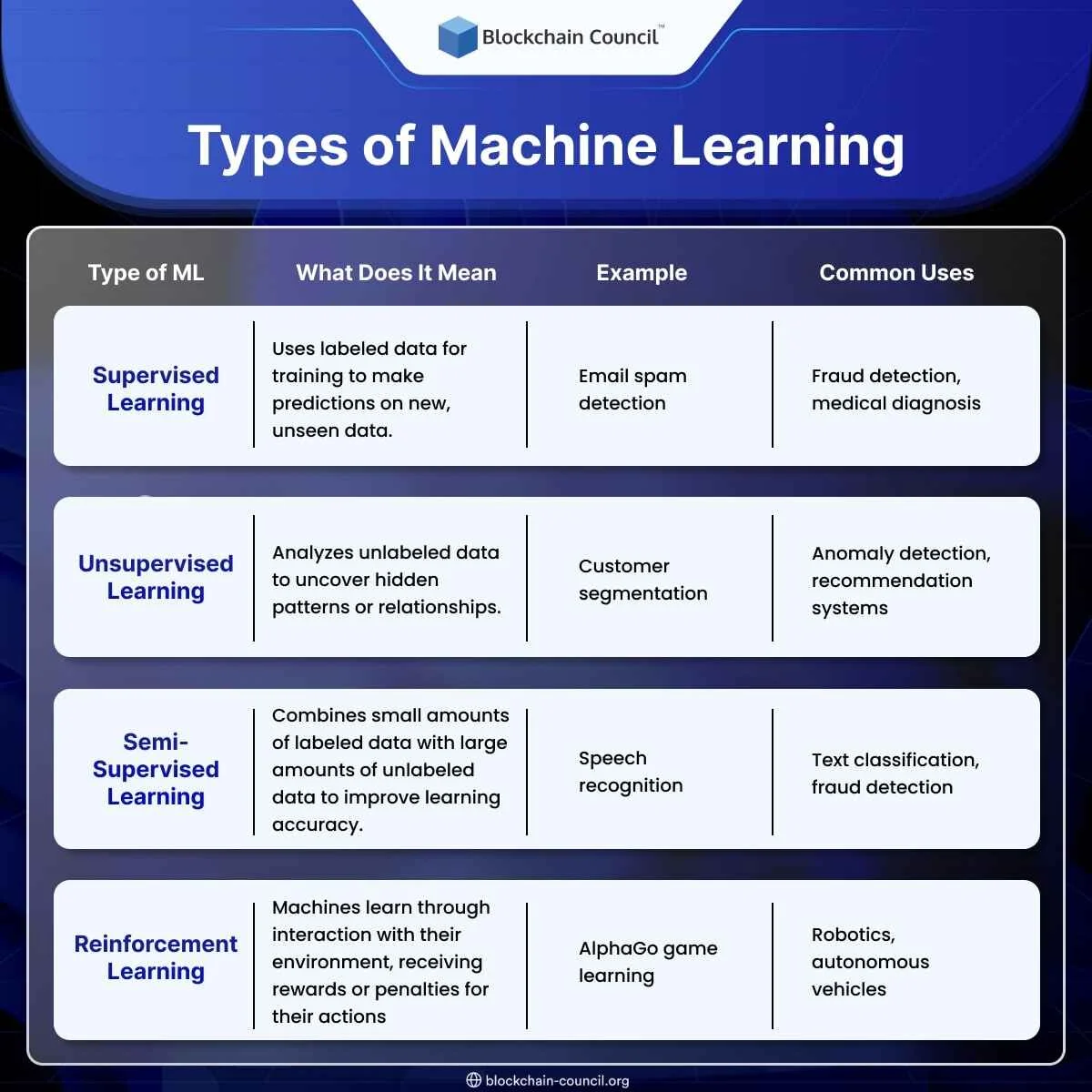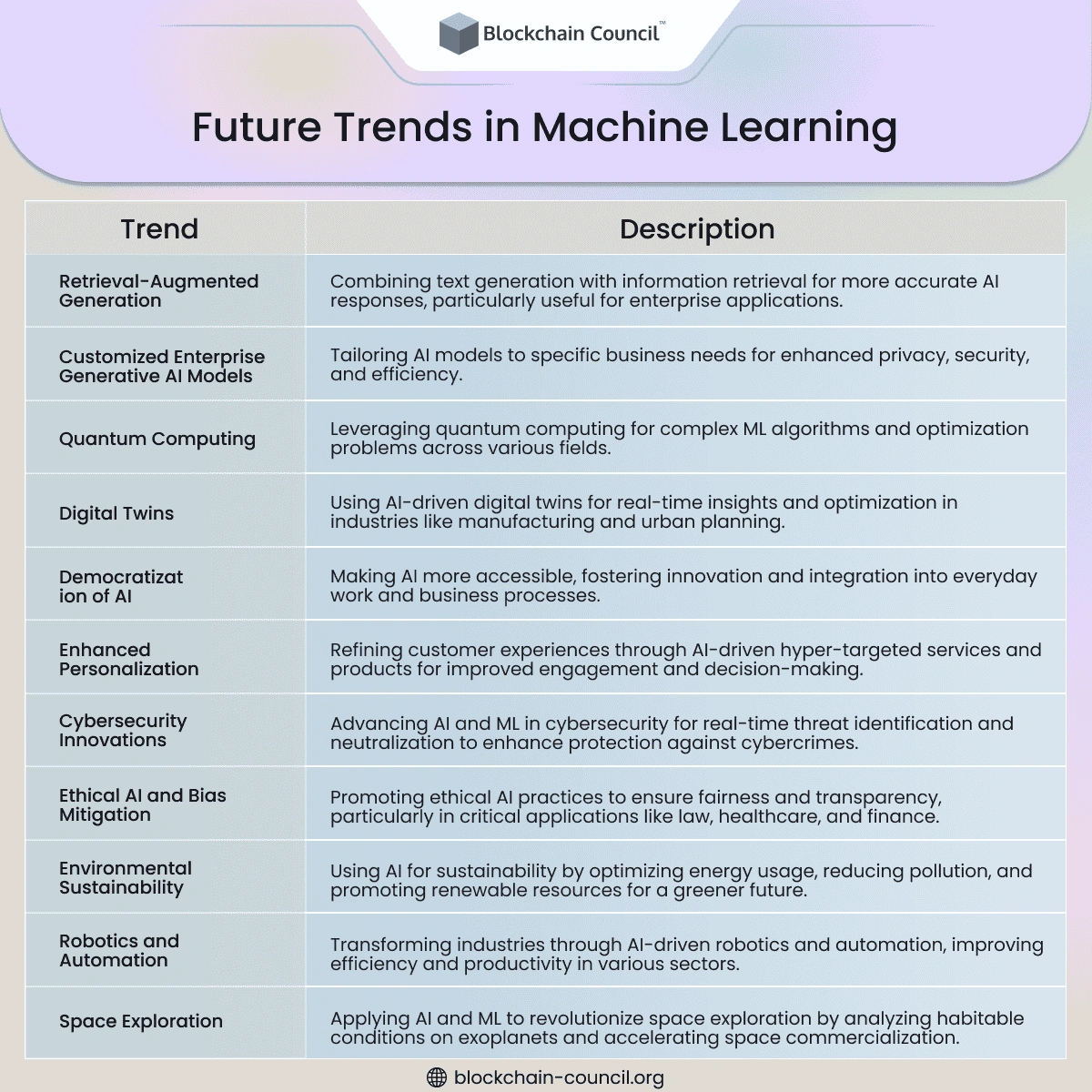
- Blockchain Council
- January 16, 2025
Machine learning is a transformative branch of artificial intelligence that empowers systems to learn and improve from experience without being explicitly programmed. It involves algorithms that analyze data, learn from it, and make decisions or predictions. Machine learning’s capability to adapt to new data independently makes it a cornerstone of modern AI applications, enhancing everything from healthcare diagnostics to personalized consumer experiences.
In this article, we will delve deep into the world of machine learning, providing you with a comprehensive understanding of what it is and how it works. By the end of this article, you will have a solid grasp of the core concepts, algorithms, and real-world applications of machine learning.
What is Machine Learning?
Machine Learning (ML) represents a transformative branch of artificial intelligence (AI) that empowers software applications to become more accurate in predicting outcomes without being explicitly programmed to do so. It revolves around the development of algorithms that can process input data and use statistical analysis to predict an output while updating outputs as new data becomes available. The essence of machine learning lies in its ability to learn from data, identify patterns, and make decisions with minimal human intervention.
Also Read: Deep Learning vs Machine Learning vs Artificial Intelligence: A Beginner’s Guide
Brief History of Machine Learning
- 1950s: The concept of machine learning is seeded by Alan Turing’s question, “Can machines think?”, leading to the development of the Turing Test to determine a machine’s ability to exhibit intelligent behavior equivalent to, or indistinguishable from, that of a human.
- 1952-1957: Arthur Samuel develops the first computer learning program, and the term “Machine Learning” is coined. The program was a checker-playing application that improved its game over time.
- 1967: The “Nearest Neighbor” algorithm was written, allowing computers to start using basic pattern recognition.
- 1980s: The popularity of machine learning is renewed with the advent of the backpropagation algorithm, which allowed neural networks to adjust hidden layers of neurons.
- 1990s: Work on machine learning shifts from a knowledge-driven approach to a data-driven approach. Scientists begin creating programs for computers to analyze large amounts of data and draw conclusions — or “learn” — from the results.
- 2000s: The development of deep learning techniques and the advent of Big Data revolutionize the field, leading to significant advancements in machine learning applications across various sectors.
Why is Machine Learning Important?
Machine learning is crucial for its ability to process and analyze vast amounts of data with increasing accuracy and efficiency. Its importance stems from the fact that it enables the automation of decision-making processes and can be applied to a wide range of industries, including healthcare, finance, education, and more. Machine learning algorithms can uncover hidden insights through data without being explicitly programmed where to look, leading to innovations in AI that seem to border on sci-fi.
Moreover, machine learning is fundamental in developing complex models that power modern AI applications, such as natural language processing, self-driving cars, and recommendation systems. By harnessing the power of machine learning, businesses and organizations can improve operational efficiencies, enhance customer experiences, and innovate continuously in an ever-evolving digital landscape.
This technology’s significance also lies in its flexibility and scalability, making it a critical tool for tackling complex problems by learning from data patterns and improving over time. As data volumes grow exponentially, machine learning’s role becomes increasingly vital in making sense of this information, making predictive analyses more accurate and reliable, and driving forward the capabilities of AI to unlock new possibilities and solutions to complex challenges.
Also Read: Top 10 Machine Learning Projects In 2024
How Does Machine Learning Work?
Machine Learning works by using algorithms to analyze data, learn from that data, and make use of the data. The process involves feeding the algorithm training data, which can be labeled (known) or unlabeled (unknown), to develop a model that can make predictions or decisions based on new data. The algorithm’s performance improves over time through a process of trial and error, adjusting its approach as it learns from the outcomes of its predictions compared to actual results. This iterative learning process enables ML models to increase in accuracy and efficiency, adapting to new data with minimal human intervention.
Types of Machine Learning
- Supervised Learning: This type involves using labeled data as a guide to predict outcomes for new, unseen data. The model learns from the training data, which has input-output pairs, aiming to make accurate predictions for new data based on learned relationships. Common tasks include classification (categorizing data into predefined labels) and regression (predicting continuous values).
- Unsupervised Learning: Unlike supervised learning, unsupervised learning deals with unlabeled data. The goal here is to explore the data and find some structure or patterns within. Typical applications include clustering (grouping similar data points together) and dimensionality reduction (simplifying the data without losing important information).
- Semi-supervised Learning: This approach falls between supervised and unsupervised learning, using a small amount of labeled data alongside a larger amount of unlabeled data. It’s particularly useful when labeling data is expensive or time-consuming, allowing the model to improve its learning with less human input.
- Reinforcement Learning: In this dynamic environment, an agent learns to achieve a goal in a complex, uncertain environment by trial and error, using feedback from its own actions and experiences rather than from a data set. Reinforcement learning is widely used in areas such as robotics, gaming, and navigation.
Also Read: Top 10 Applications Of Machine Learning
Common Terms Explained
| Term | Definition |
| Algorithm | A set of rules or instructions given to an ML model to learn from data. |
| Model | The outcome of running a machine learning algorithm on data, representing what the algorithm has learned. |
| Training Data | Data used to train an ML model. This data is fed to the model so it can learn and make predictions. |
| Label | In supervised learning, the answer or outcome the model is predicting. Labels are part of the training data. |
| Feature | An individual measurable property or characteristic of the data being observed. Features are used as inputs for ML models to make predictions or decisions. |
| Accuracy | A metric to measure how often the ML model makes correct predictions. It’s crucial for evaluating the performance of classification models. |
| Regression | A type of machine learning task that involves predicting continuous values (e.g., price of a house, temperature) based on one or more variables. |
| Classification | A task in machine learning that categorizes data into predefined labels or classes (e.g., spam or not spam in email filtering). |
| Clustering | An unsupervised learning task that groups a set of objects in such a way that objects in the same group are more similar to each other than to those in other groups. |
| Overfitting | A modeling error in machine learning when a model is too closely fitted to the training data and may not perform well on unseen data. |
| Underfitting | Occurs when a model is too simple to learn the underlying structure of the data and fails to capture the target variable’s variability. |
| Neural Network | A series of algorithms that attempt to recognize underlying relationships in a set of data through a process that mimics the way the human brain operates. |
Applications of Machine Learning
Machine Learning (ML) is not just a futuristic concept but a present reality, deeply embedded in various aspects of our daily lives and the backbone of numerous future innovations. From enhancing social media experiences to revolutionizing healthcare, ML’s applications are vast and varied. Below, we delve into some of these applications, illustrating the breadth of ML’s impact on our world:
- Social Media Features: Platforms like Facebook use ML to analyze user activity—such as likes, comments, and time spent on posts—to tailor friend and content suggestions. This personalization enhances user engagement and the overall social media experience.
- Product Recommendations: E-commerce giants leverage ML algorithms to offer personalized product suggestions based on users’ browsing history, purchase patterns, and cart contents. This not only improves the shopping experience but also boosts sales.
- Image Recognition: A significant application of ML is in identifying objects or features in digital images. This technology powers everything from organizing your photo library to security systems that can recognize faces.
- Sentiment Analysis: ML algorithms can determine the tone and emotion behind text input, such as reviews or social media posts. This is incredibly valuable for businesses to gauge customer sentiment and tailor their strategies accordingly.
- Healthcare Efficiency: In the healthcare sector, ML algorithms predict patient wait times and optimize the allocation of resources. They’re also crucial in disease detection, treatment planning, and monitoring patient health outcomes.
- Finance and Banking: Banks and financial institutions use ML to detect fraudulent transactions and prevent hacking attempts. These systems analyze transaction patterns to identify and block suspicious activities.
- Language Translation: ML has significantly advanced language translation, making it possible to translate texts between languages accurately and contextually. This has removed language barriers, fostering global communication and understanding.
Also Read: Top 10 Must-Have Machine Learning Skills
Challenges and Considerations
Data Privacy and Security
Machine learning processes vast amounts of data, raising significant data privacy and security concerns. Ensuring the confidentiality and integrity of data while leveraging it for ML applications is paramount. This involves complying with data protection regulations, securing data storage and transfer, and implementing robust access controls.
Ethical Implications of Machine Learning
The deployment of ML systems comes with ethical implications, including bias, fairness, and transparency. It’s crucial to develop and train ML models responsibly, ensuring they do not perpetuate or amplify biases present in the training data, and decisions made by algorithms are explainable and fair.
Limitations of Machine Learning
ML models are only as good as the data they are trained on and the assumptions they are built upon. They may not handle novel situations well if those scenarios were not represented in the training data. Furthermore, over-reliance on ML can lead to overlooking simpler, more efficient solutions.
Future Trends in Machine Learning
Conclusion
Machine learning stands as a pillar of technological advancement, driving innovation across numerous fields. Its ability to process and learn from vast amounts of data autonomously has opened new avenues for problem-solving and efficiency. As machine learning continues to evolve, its impact on our daily lives and future possibilities expands, marking an era of unprecedented growth in intelligent systems.
Frequently Asked Questions
What is Machine Learning?
- Machine learning is a subset of AI that enables systems to learn from data, identify patterns, and make decisions with minimal human intervention.
How Does Machine Learning Work?
- It works by using algorithms to analyze data, learn from it, and make informed decisions or predictions based on its learning.
Why is Machine Learning Important?
- It’s crucial because it allows for the automation of decision-making processes and is versatile across many industries, leading to significant advancements and efficiencies.
What are the Types of Machine Learning?
- The three main types are supervised learning, unsupervised learning, and reinforcement learning, each with unique applications and methodologies.
Can Machine Learning Predict the Future?
- While it can’t predict the future with certainty, machine learning can make accurate predictions based on historical data, identifying trends and patterns.







































































 Guides
Guides News
News Blockchain
Blockchain Cryptocurrency
& Digital Assets
Cryptocurrency
& Digital Assets Web3
Web3 Metaverse & NFTs
Metaverse & NFTs
